Abstract
OBJECTIVES: To evaluate the risk of having a child with a congenital anomaly in relation to occupational exposure to low level ionising radiation in the pre-conception period. METHODS: A case-control study based on the Canadian congenital anomalies registry used record linkage techniques to identify congenital anomalies among male and female workers in Canada's largest electric company. Cases were defined as parents of a child with a congenital anomaly born between April 1979 and December 1986 who had a congenital anomaly diagnosed within the first year of life. Controls were an individually matched sample of parents of a liveborn child without an anomaly. Risk of congenital anomaly was assessed in relation to parental exposure to ionising radiation acquired through work within a nuclear generating station of an electric power company. Exposure was assessed according to employment, whether or not the worker was monitored for radiation exposure, and quantitative estimates of radiation dose. RESULTS: Employment within the electric power industry was not associated with an increased risk of congenital anomalies in the offspring of mothers or fathers. Risk estimates for workers monitored (those who are likely to be exposed to ionising radiation) were 1.75 (95% confidence interval (95% CI) 0.86 to 3.55) for mothers and 0.84 (95% CI 0.68 to 1.05) for fathers. Exposure for fathers before conception, defined cumulatively and for six months before conception, was not associated with increased risk of anomalies in their offspring. There were no significant increases in risk found between type of anomaly and any measure of exposure, although the statistical power in these groups was limited. The study had insufficient numbers to evaluate the effects of ionising radiation in mothers as only three mothers had recorded doses > 0 mSv. CONCLUSIONS: Overall, workers in a nuclear power industry, and specifically those exposed before conception to low levels of ionising radiation, do not appear to be at an increased risk of having a liveborn child with a congenital anomaly.
Full text
PDF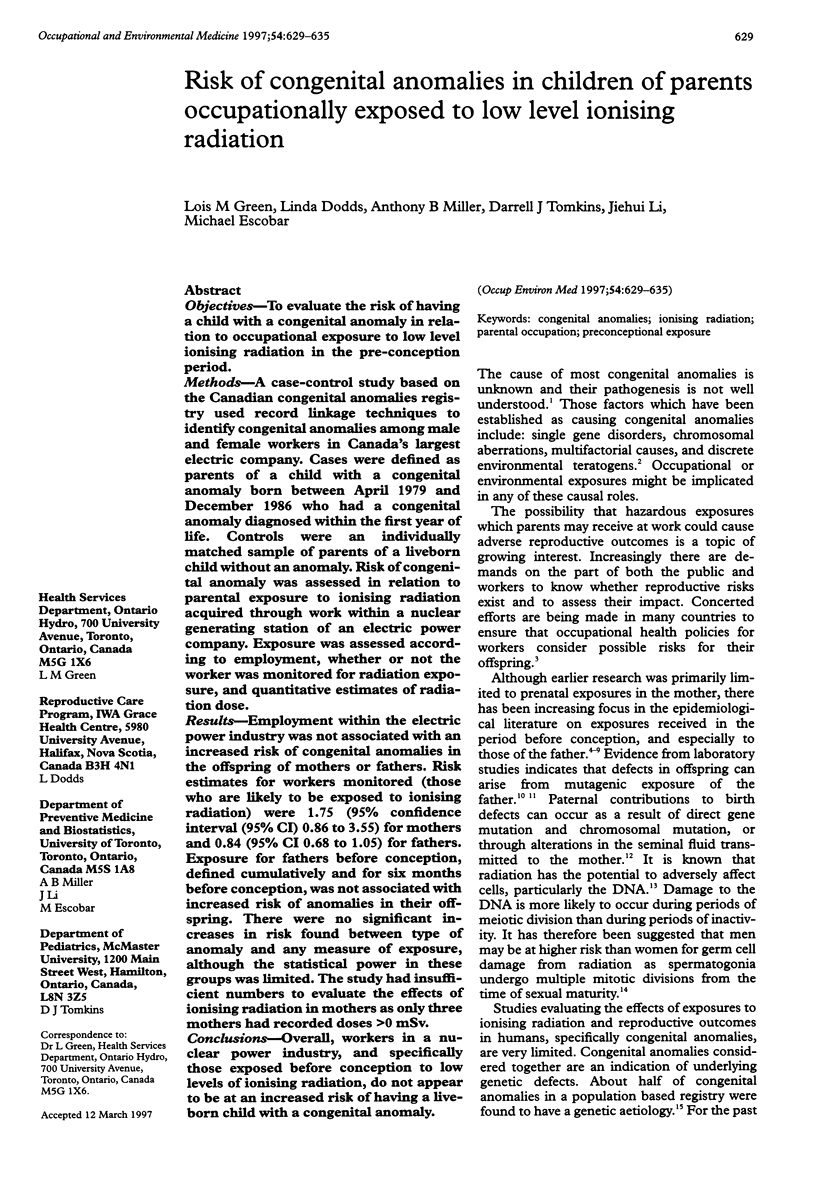
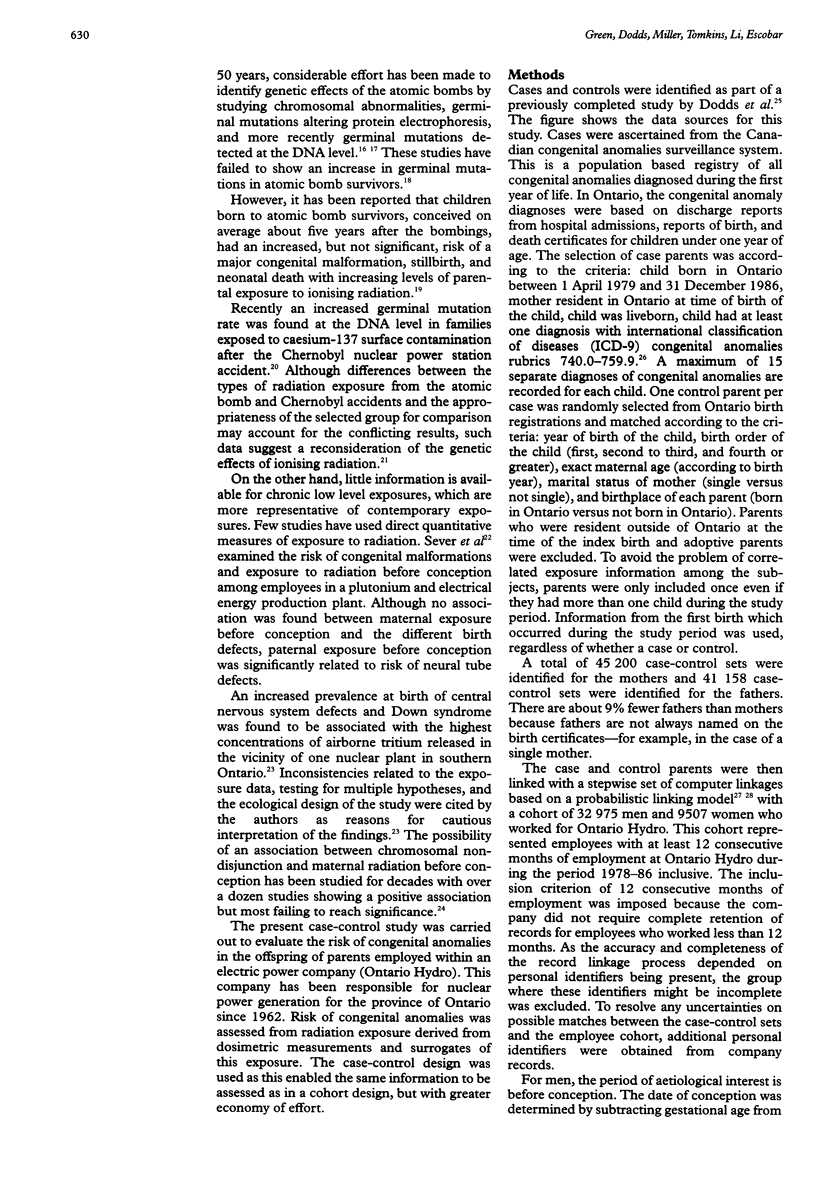
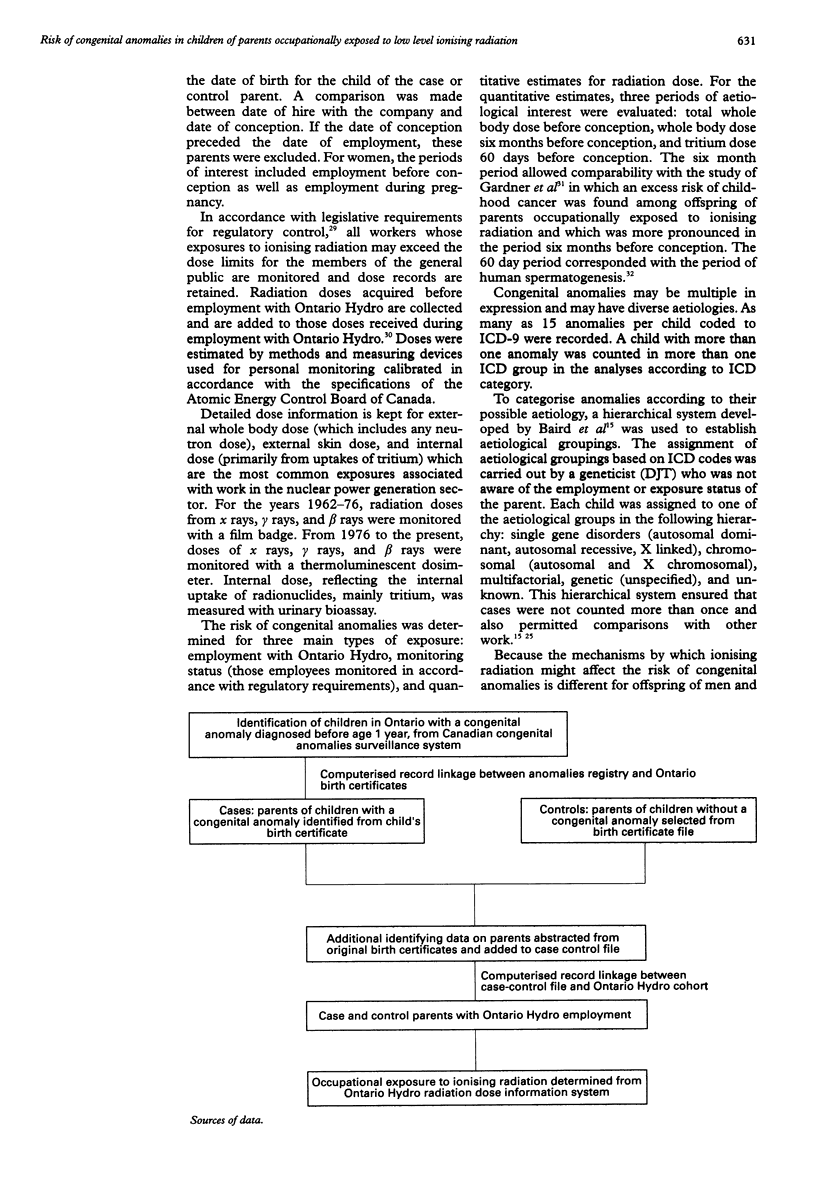

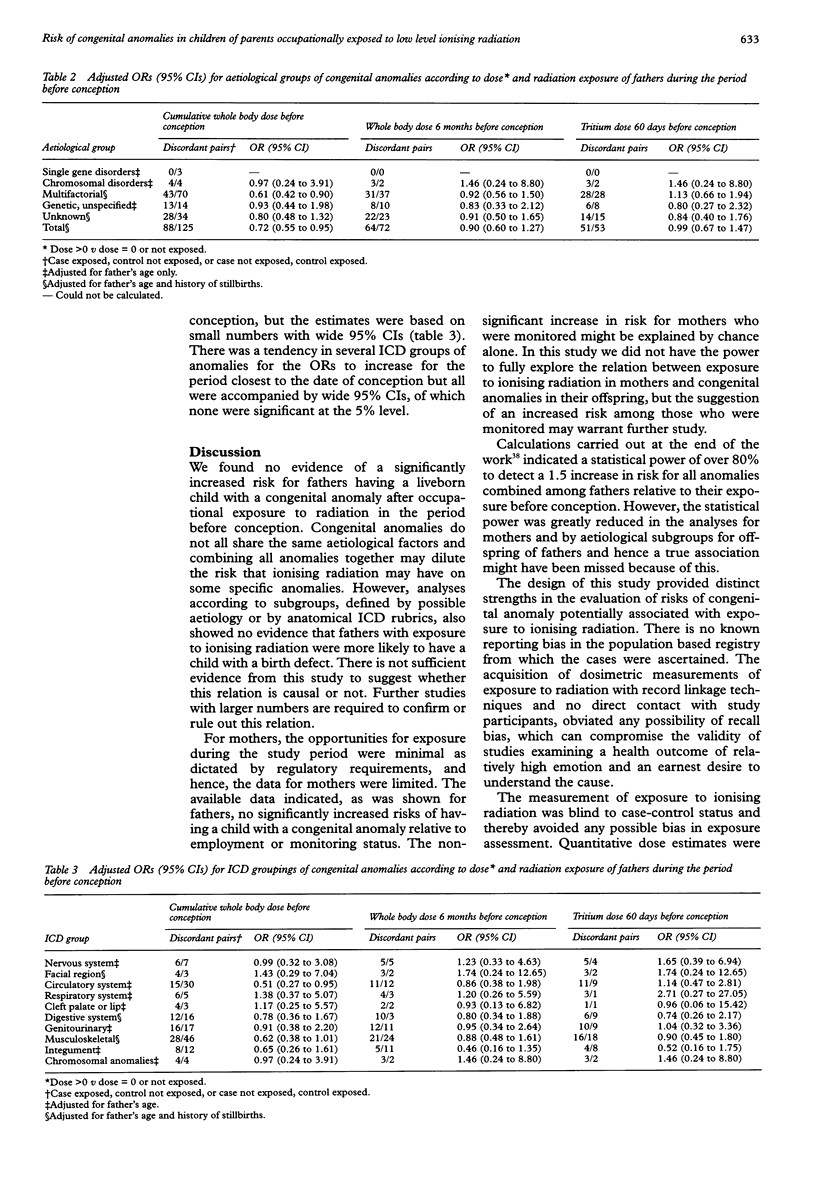
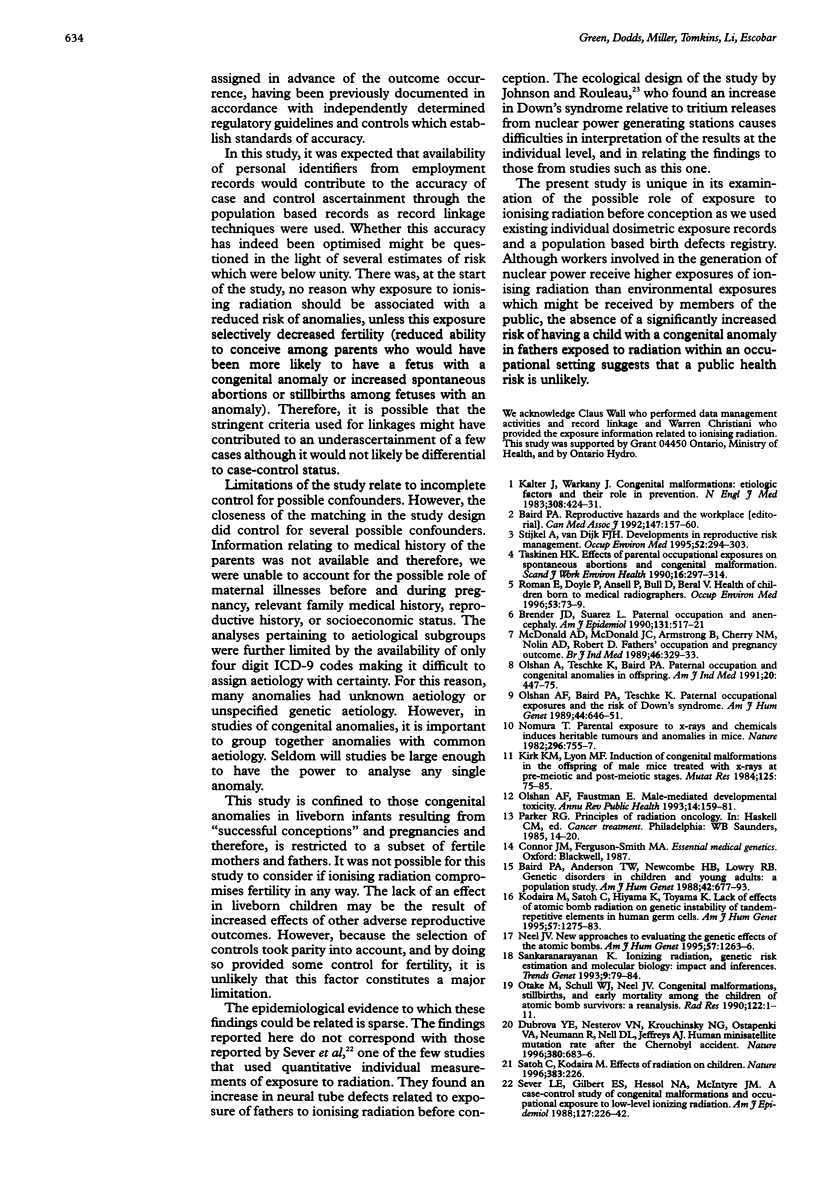
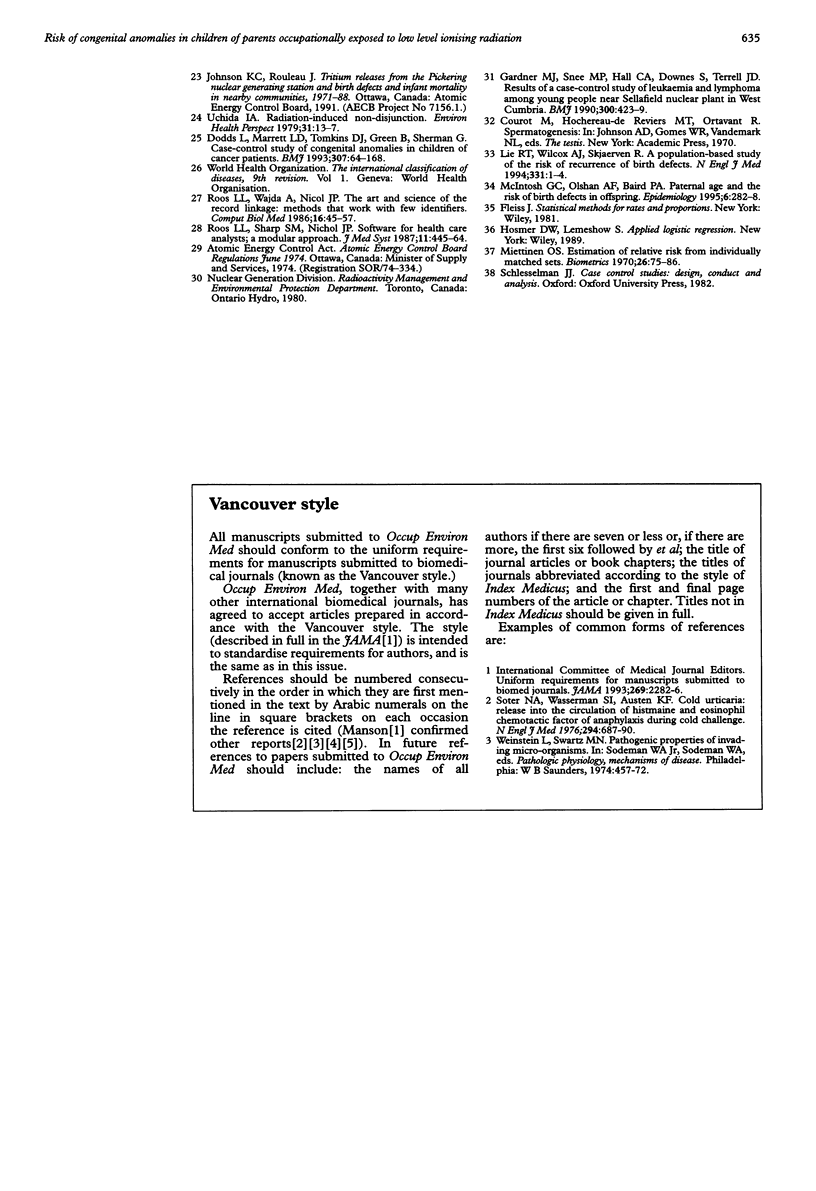
Selected References
These references are in PubMed. This may not be the complete list of references from this article.
- Baird P. A., Anderson T. W., Newcombe H. B., Lowry R. B. Genetic disorders in children and young adults: a population study. Am J Hum Genet. 1988 May;42(5):677–693. [PMC free article] [PubMed] [Google Scholar]
- Baird P. A. Reproductive hazards and the workplace. CMAJ. 1992 Jul 15;147(2):157–160. [PMC free article] [PubMed] [Google Scholar]
- Brender J. D., Suarez L. Paternal occupation and anencephaly. Am J Epidemiol. 1990 Mar;131(3):517–521. doi: 10.1093/oxfordjournals.aje.a115526. [DOI] [PubMed] [Google Scholar]
- Dodds L., Marrett L. D., Tomkins D. J., Green B., Sherman G. Case-control study of congenital anomalies in children of cancer patients. BMJ. 1993 Jul 17;307(6897):164–168. doi: 10.1136/bmj.307.6897.164. [DOI] [PMC free article] [PubMed] [Google Scholar]
- Dubrova Y. E., Nesterov V. N., Krouchinsky N. G., Ostapenko V. A., Neumann R., Neil D. L., Jeffreys A. J. Human minisatellite mutation rate after the Chernobyl accident. Nature. 1996 Apr 25;380(6576):683–686. doi: 10.1038/380683a0. [DOI] [PubMed] [Google Scholar]
- Gardner M. J., Snee M. P., Hall A. J., Powell C. A., Downes S., Terrell J. D. Results of case-control study of leukaemia and lymphoma among young people near Sellafield nuclear plant in West Cumbria. BMJ. 1990 Feb 17;300(6722):423–429. doi: 10.1136/bmj.300.6722.423. [DOI] [PMC free article] [PubMed] [Google Scholar]
- Kalter H., Warkany J. Medical progress. Congenital malformations: etiologic factors and their role in prevention (first of two parts). N Engl J Med. 1983 Feb 24;308(8):424–431. doi: 10.1056/NEJM198302243080804. [DOI] [PubMed] [Google Scholar]
- Kirk K. M., Lyon M. F. Induction of congenital malformations in the offspring of male mice treated with X-rays at pre-meiotic and post-meiotic stages. Mutat Res. 1984 Jan;125(1):75–85. doi: 10.1016/0027-5107(84)90034-4. [DOI] [PubMed] [Google Scholar]
- Kodaira M., Satoh C., Hiyama K., Toyama K. Lack of effects of atomic bomb radiation on genetic instability of tandem-repetitive elements in human germ cells. Am J Hum Genet. 1995 Dec;57(6):1275–1283. [PMC free article] [PubMed] [Google Scholar]
- Lie R. T., Wilcox A. J., Skjaerven R. A population-based study of the risk of recurrence of birth defects. N Engl J Med. 1994 Jul 7;331(1):1–4. doi: 10.1056/NEJM199407073310101. [DOI] [PubMed] [Google Scholar]
- McDonald A. D., McDonald J. C., Armstrong B., Cherry N. M., Nolin A. D., Robert D. Fathers' occupation and pregnancy outcome. Br J Ind Med. 1989 May;46(5):329–333. doi: 10.1136/oem.46.5.329. [DOI] [PMC free article] [PubMed] [Google Scholar]
- McIntosh G. C., Olshan A. F., Baird P. A. Paternal age and the risk of birth defects in offspring. Epidemiology. 1995 May;6(3):282–288. doi: 10.1097/00001648-199505000-00016. [DOI] [PubMed] [Google Scholar]
- Miettinen O. S. Estimation of relative risk from individually matched series. Biometrics. 1970 Mar;26(1):75–86. [PubMed] [Google Scholar]
- Neel J. V. New approaches to evaluating the genetic effects of the atomic bombs. Am J Hum Genet. 1995 Dec;57(6):1263–1266. [PMC free article] [PubMed] [Google Scholar]
- Olshan A. F., Baird P. A., Teschke K. Paternal occupational exposures and the risk of Down syndrome. Am J Hum Genet. 1989 May;44(5):646–651. [PMC free article] [PubMed] [Google Scholar]
- Olshan A. F., Faustman E. M. Male-mediated developmental toxicity. Annu Rev Public Health. 1993;14:159–181. doi: 10.1146/annurev.pu.14.050193.001111. [DOI] [PubMed] [Google Scholar]
- Olshan A. F., Teschke K., Baird P. A. Paternal occupation and congenital anomalies in offspring. Am J Ind Med. 1991;20(4):447–475. doi: 10.1002/ajim.4700200403. [DOI] [PubMed] [Google Scholar]
- Otake M., Schull W. J., Neel J. V. Congenital malformations, stillbirths, and early mortality among the children of atomic bomb survivors: a reanalysis. Radiat Res. 1990 Apr;122(1):1–11. [PubMed] [Google Scholar]
- Roman E., Doyle P., Ansell P., Bull D., Beral V. Health of children born to medical radiographers. Occup Environ Med. 1996 Feb;53(2):73–79. doi: 10.1136/oem.53.2.73. [DOI] [PMC free article] [PubMed] [Google Scholar]
- Roos L. L., Jr, Wajda A., Nicol J. P. The art and science of record linkage: methods that work with few identifiers. Comput Biol Med. 1986;16(1):45–57. doi: 10.1016/0010-4825(86)90061-2. [DOI] [PubMed] [Google Scholar]
- Roos L. L., Jr, Wajda A., Sharp S. M., Nicol J. P. Software for health care analysts: a modular approach. J Med Syst. 1987 Dec;11(6):445–464. doi: 10.1007/BF00993011. [DOI] [PubMed] [Google Scholar]
- Sankaranarayanan K. Ionizing radiation, genetic risk estimation and molecular biology: impact and inferences. Trends Genet. 1993 Mar;9(3):79–84. doi: 10.1016/0168-9525(93)90228-a. [DOI] [PubMed] [Google Scholar]
- Satoh C., Kodaira M. Effects of radiation on children. Nature. 1996 Sep 19;383(6597):226–226. doi: 10.1038/383226a0. [DOI] [PubMed] [Google Scholar]
- Sever L. E., Gilbert E. S., Hessol N. A., McIntyre J. M. A case-control study of congenital malformations and occupational exposure to low-level ionizing radiation. Am J Epidemiol. 1988 Feb;127(2):226–242. doi: 10.1093/oxfordjournals.aje.a114799. [DOI] [PubMed] [Google Scholar]
- Stijkel A., van Dijk F. J. Developments in reproductive risk management. Occup Environ Med. 1995 May;52(5):294–303. doi: 10.1136/oem.52.5.294. [DOI] [PMC free article] [PubMed] [Google Scholar]
- Taskinen H. K. Effects of parental occupational exposures on spontaneous abortion and congenital malformation. Scand J Work Environ Health. 1990 Oct;16(5):297–314. doi: 10.5271/sjweh.1779. [DOI] [PubMed] [Google Scholar]
- Uchida I. A. Radiation-induced nondisjunction. Environ Health Perspect. 1979 Aug;31:13–17. doi: 10.1289/ehp.793113. [DOI] [PMC free article] [PubMed] [Google Scholar]


